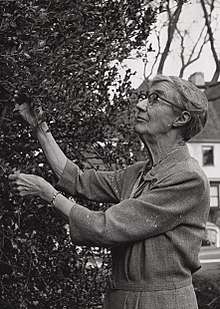Edith R. Mirrielees
Professor Edith Ronald Mirrielees (September 10, 1878 - June 3, 1962) was a pioneering teacher of creative writing; she inspired many talented, distinguished students, including novelist John Steinbeck at Stanford University.

Biography
Edith Ronald Mirrielees was born on September 10, 1878, in Pittsfield, Illinois, and grew up in Big Timber, Montana.[1]
Before graduating, she taught in Montana public schools.[1] At 25 years old, in 1903, Mirrielees entered Stanford University to study History (later changed to English).[1] She graduated in 1906, B.A. in 1907. As a student, she was the editor of the literary magazine, Sequoia, the associate editor of the yearbook, Stanford Quad, and co-founder of the women's honorary society, Cap and Gown.[2]
From 1909 to 1944 she was first instructor and then professor of English literature at Stanford University.[2] She is best known for her courses in Creative Writing and for the influence she had on such famous American writers as John Steinbeck,[3] Howard Pease, Archie Binns, Allen Drury,[1] and Irma Hannibal.[4] Her book Story Writing is an essential reference in the field.[5][1]
During World War I she served with the Stanford Red Cross unit in France. She was an advisor on educational matters to the Bureau of Indian Affairs.[1]
After retirement, she founded and published the magazine Pacific Spectator (1947-1951).[1][6]
In 1951 she wrote the foreword for the speculative fiction anthology World of Wonder, edited by Fletcher Pratt.
In 1959 she published Stanford: The Story of a University.[7][2][1]
In 1961, Mills College awarded her an honorary doctorate in Letters in recognition of her outstanding contribution as a professor.[1]
She spent the last year of her life writing Stanford mosaic: reminiscences of the first seventy years at Stanford University , a tale of memories of Stanford's first seventy years.[8][1]
She corresponded with Avis De Voto, Bernard De Voto, Mary Stegner, Wallace Stegner, and Harry Bush.[9] She was friends with Robert Frost.[10]
Mirrielees died on June 3, 1962, in Stanford, California.[1]
Legacy
Mirrielees House at Stanford University is an apartment residence used primarily for upperclass students.[2]
Stanford University endows the Edith Mirrielees Professorship in Creative Writing.
Montana State University holds the Edith R. Mirrielees Prize competition.
References
- "Memorial Resolution – Edith Ronald Mirrielees (1878–1962)" (PDF). stanford. Retrieved 10 January 2018.
- "Mirrielees House". Stanford University. Retrieved 10 January 2018.
- "It has never got easier". Letters of Note. Retrieved 10 January 2018.
- "restricted access Two Views of Stanford's Teaching Legends: Margery Bailey and Edith Mirrielees and Their Effect on John Steinbeck and Irma Hannibal". Project Muse. Retrieved 10 January 2018.
- Edith Ronald Mirrielees, Story Writing, Wilside Press LLC, 2008
- Carnochan, W. B. "English Stanford 1891–2000 A Brief History". Retrieved 10 January 2018.
- Edith R. Mirrielees, Stanford, the Story of a University, Putnam, New York, 1959
- Edith Ronald Mirrielees, Stanford mosaic; reminiscences of the first seventy years at Stanford University, Stanford Calif. Stanford University Press (1962), ASIN:B002CPS42M
- "Guide to the Edith R. Mirrielees Papers". The Online Archive of California. Retrieved 10 January 2018.
- Stanlis, Peter J. (2011). Conversations with Robert Frost: The Bread Loaf Period. Transaction Publishers. p. 84. Retrieved 10 January 2018.
External links
- Works by Edith R. Mirrielees at LibriVox (public domain audiobooks)
